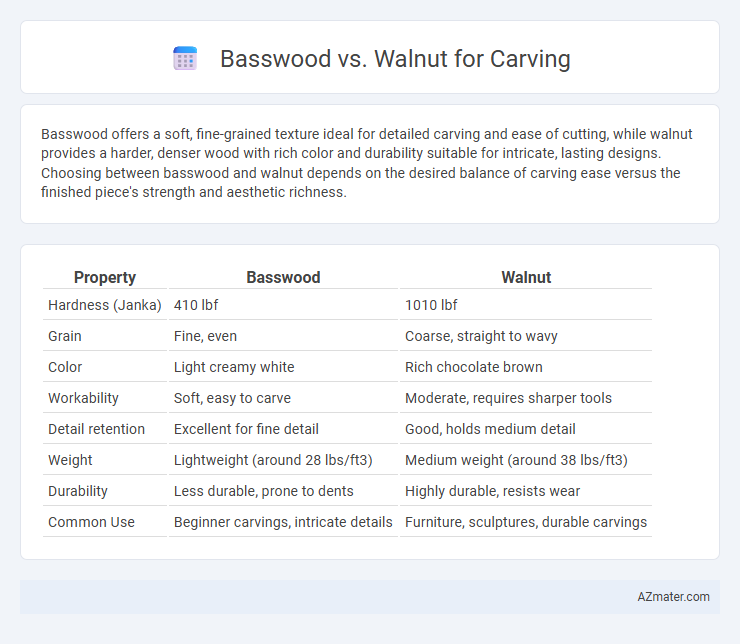Basswood offers a soft, fine-grained texture ideal for detailed carving and ease of cutting, while walnut provides a harder, denser wood with rich color and durability suitable for intricate, lasting designs. Choosing between basswood and walnut depends on the desired balance of carving ease versus the finished piece's strength and aesthetic richness.
Table of Comparison
| Property | Basswood | Walnut |
|---|---|---|
| Hardness (Janka) | 410 lbf | 1010 lbf |
| Grain | Fine, even | Coarse, straight to wavy |
| Color | Light creamy white | Rich chocolate brown |
| Workability | Soft, easy to carve | Moderate, requires sharper tools |
| Detail retention | Excellent for fine detail | Good, holds medium detail |
| Weight | Lightweight (around 28 lbs/ft3) | Medium weight (around 38 lbs/ft3) |
| Durability | Less durable, prone to dents | Highly durable, resists wear |
| Common Use | Beginner carvings, intricate details | Furniture, sculptures, durable carvings |
Introduction to Basswood and Walnut for Carving
Basswood is favored for carving due to its soft texture, fine grain, and ease of shaping, making it ideal for beginners and intricate designs. Walnut offers a harder, denser wood with a rich dark color and pronounced grain, preferred for detailed work requiring durability and a striking finish. Both woods provide unique qualities for carving, with basswood excelling in malleability and walnut in strength and aesthetic appeal.
Wood Characteristics: Basswood vs Walnut
Basswood offers a soft, fine-grained texture that makes it ideal for detailed carving and beginner woodworkers, with its light color enhancing visible precision. Walnut features a hardwood composition with a rich, dark brown hue and a tighter grain, providing durability and a striking contrast in finished carvings. Both woods carve well, but basswood's softness allows for easier cuts, while walnut requires sharper tools and provides a more polished, elegant finish.
Workability: Ease of Carving
Basswood offers superior workability due to its soft texture and fine, even grain, making it ideal for detailed carving and beginner sculptors. Walnut, while harder and denser, provides a smoother finish and holds intricate details well but requires sharper tools and more effort. Carvers seeking ease and speed often prefer basswood, whereas walnut suits projects demanding durability and rich color.
Grain Structure and Texture Comparison
Basswood features a fine, even grain and a soft, smooth texture that allows for precise, detailed carving, making it a favorite among beginners and intricate projects. Walnut exhibits a tighter, more pronounced grain with a harder texture, offering durability and rich color contrast, ideal for carvings requiring strength and aesthetic depth. The subtle grain of basswood minimizes tool resistance, while walnut's distinct grain patterns enhance visual appeal but demand sharper tools for clean cuts.
Durability and Hardness Differences
Basswood offers a softer texture with a Janka hardness rating of approximately 410, making it ideal for detailed carving and intricate designs due to its ease of cutting and minimal wear on tools. Walnut, with a significantly higher Janka hardness around 1010, provides greater durability and resistance to dents and scratches, suited for projects requiring long-lasting strength and a polished finish. The choice between basswood and walnut hinges on the balance between ease of carving and the desired toughness of the final piece.
Color and Finish Potential
Basswood features a pale, creamy color that provides a uniform surface ideal for detailed carving and smooth finishes, making it easy to stain or paint to achieve various effects. Walnut offers a rich, dark brown hue with natural grain patterns that enhance the depth and visual appeal of carved pieces, producing a luxurious finish without much additional treatment. The finish potential of basswood allows for versatility in color customization, while walnut's inherent natural beauty shines best with clear finishes or light oiling to preserve its elegant tone.
Suitability for Detail Work
Basswood is highly suitable for intricate carving due to its fine, even grain and softness, allowing for precise detail work and smooth finishes. Walnut, while harder and denser, offers a rich color and durability but requires sharper tools and more effort to achieve fine detail without chipping. Carvers seeking ease of shaping and delicate patterns often prefer basswood, whereas walnut is chosen for projects where durability and aesthetic richness are prioritized.
Common Carving Applications
Basswood and walnut each serve distinct purposes in carving due to their unique textures and hardness. Basswood is favored for intricate and detailed work, such as relief carvings, whittling, and figure carving, because of its soft, fine-grained structure that carves smoothly with minimal effort. Walnut, with its dense and durable hardwood characteristics, is preferred for larger projects like furniture accents, decorative bowls, and sculptural pieces that require strength and a rich, dark finish.
Cost and Availability
Basswood is widely favored for carving due to its affordability and consistent availability in most woodworking stores, often costing significantly less than walnut. Walnut, while more expensive, is prized for its rich color and fine grain but can be harder to source, especially in larger or select cuts. The cost difference makes basswood ideal for beginners or large projects, whereas walnut is preferred for detailed, high-quality pieces where aesthetics are a priority.
Choosing the Right Wood for Your Project
Basswood offers a soft, fine-grained texture that is ideal for intricate carving and detail work, making it a favorite among beginners and professionals alike. Walnut provides a denser, harder surface with rich color and natural grain patterns, perfect for projects requiring durability and a more polished finish. Selecting between basswood and walnut depends on the desired level of detail, hardness, and final appearance needed for your carving project.

Infographic: Basswood vs Walnut for Carving
 azmater.com
azmater.com